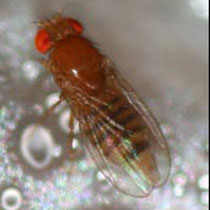The trigger was a gene. In service to humanity was a tiny fly, Drosophila spp aka fruit fly. This space pioneer that was flown to space first for radiation studies has been a model in genetics and cancer research. Some three quarters of human genes are found to have an equivalent in the fruit fly. Those pretty red eyes in the Drosophila photo have given us a clue to control cancer.
 Photo: University of Nebraska - Lincoln
Photo: University of Nebraska - Lincoln
Just imagine: if you could find a gene that acts like switch for cancer, you could treat and cure cancer. What is cancer any way? Cancer is characterized in cells by three malignant properties, (1) uncontrolled growth that is (2) invasive, and (3) possibly metastasizing in the body. A cancer suppressor gene idea was conceived earlier as a possibility to protect the cells on the cancer path.
Atonal homolog 1 is a gene in the Drosophila melanogaster. The equivalent gene in mice and humans is called ATOH1. Both are thought to be key cell differentiation controllers. Bassem A. Hassan and team have published their methods and results in two elegant scientific articles.[1-2]
These researchers show that "genes, such as atonal, that instruct the differentiation of specific tissues can act as tumor suppressers and inhibit the formation and progression of tumors in those tissues. Losing such genes can generate tumors, whereas activating them can strongly inhibit these tumors."[1]
Their research demonstrated that "colon-specific loss of ATOH1 in mice is sufficient to trigger colon cancer and that the majority of human colon cancers also have an inactivated ATOH1. Reactivating ATOH1 in cultured human colon cancer cells causes these cells to stop dividing and to commit suicide."[2]
Figure 5 in the second article illustrates how ATOH1 suppresses growth by Interfering with the cell cycle:
http://biology.plosjournals.org/perlserv/?request=slideshow&type=figure&doi=10.1371/journal.pbio.1000039&id=104631
To summarize:
1. ATOH1 suppressed colon cancer in both mice and humans. Similarly, Drosophila ato prevented eye tumor development in fruit flies.
2. Switching off the gene triggered the growth of cancers in fruit flies, mice, and humans.
3. Mice missing ATOH1 developed colon cancer.
4. Likewise, the gene was frequently inactivated in humans with the disease.
5. Reactivating the gene in test-tube cancer cells caused the tumors to stop dividing and commit suicide.
6. Reactivation of the gene was accomplished with a rather simple chemical compound.
Future studies:
Because reactivation of the "epigenetically silenced gene can be achieved using small chemical compounds," understanding how ATOH1 works should lead to new therapies in the future. A new strategy was thus born in cancer treatment and cure. Bassem A. Hassan and colleagues are to be congratulated for their accomplshments so far.
Articles cited:
[1] Wouter Bossuyt, Natalie De Geest, Stein Aerts, Iris Leenaerts, Peter Marynen, Bassem A. Hassan. (2009) The Atonal proneural transcription factor links differentiation and tumor formation in Drosophila. PLoS Biol 7(2): e1000040. doi:10.1371/journal.pbio.1000040
http://biology.plosjournals.org/perlserv/?request=get-document&doi=10.1371/journal.pbio.1000040
[2] Wouter Bossuyt, Avedis Kazanjian, Natalie De Geest, Sofie Van Kelst, Gert De Hertogh, Karel Geboes, Greg P. Boivin, Judith Luciani, Francois Fuks, Marinee Chuah, Thierry VandenDriessche, Peter Marynen, Jan Cools, Noah F. Shroyer, Bassem A. Hassan. (2009) Atonal homolog 1 is a tumor suppressor gene. PLoS Biol 7(2): e1000039. doi:10.1371/journal.pbio.1000039
http://biology.plosjournals.org/perlserv/?request=get-document&doi=10.1371/journal.pbio.1000039




Comments